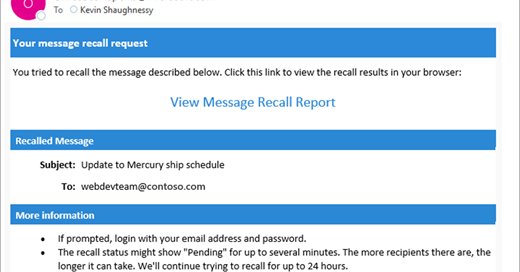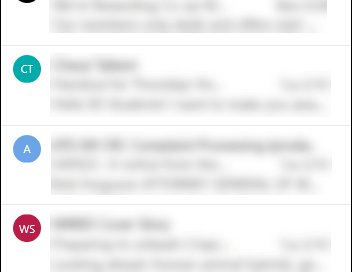How to Recall or Replace an Email in Outlook

Table of contents
Have you ever hit ‘send’ on an email only to experience a sinking feeling a few seconds later because you spotted a glaring mistake in that email?
It could be a typo in a client’s name, sending the email to the wrong person, or forgetting to attach an important document. These small errors can sometimes lead to huge misunderstandings and also negatively impact your professional image.
Fortunately, Microsoft Outlook has a feature to help you out in such awkward situations. It offers an email recall feature that helps you retrieve a sent email.
It seems like a blessing in disguise, right? We’ve created this comprehensive guide, listing the important steps to recall or replace an email in Outlook.
Table of Contents
- Step-by-step Guide to Recall an Email in Outlook
- When Should I Recall an Email in Outlook
- What Happens After I’ve Recalled an Email in Outlook
- Frequently Asked Questions (FAQs)
- Conclusion
Step-by-step Guide to Recall an Email in Outlook
With Microsoft Outlook’s recall and replace feature, you can take back emails that haven’t been opened yet. You can even replace them if you forgot to add something to the email, like an attachment.
Below are the steps for recalling or replacing an email in four different versions of Outlook. Find the version you use and follow the steps to fix your email quickly.
1. Recall/Replace in New Outlook
Here’s how you can recall and replace an email in the New Outlook version:
- Open the Sent Email: Navigate to the ‘Sent Items’ folder in the left folder pane. Double-click the email you wish to recall to open it in a separate window.
- Initiate Recall: Click on the ‘Recall Message’ button in the ribbon. Confirm your action by selecting ‘OK’ in the pop-up dialog box.
- Check Recall Status: Shortly after your action, you’ll receive a ‘Message Recall Report’ in your inbox. Click the link provided in the message to see whether the recall was successful, pending, or failed.
2. Recall/Replace in Classic Outlook
Below are the detailed steps to recall and replace a message in Classic Outlook.
- Access Sent Items: In the Outlook window, go to the ‘Sent Items’ folder in the left folder pane.
- Open the Message: Double-click the message you want to recall. (Note: Simply selecting the message won’t enable recall; it must be opened in a separate window.)
- Recall the Email: If you have the Classic Ribbon, go to the ‘Message’ tab, select ‘Actions’, and then choose ‘Recall This Message’.

- If you have the Simplified Ribbon, select the ‘Message’ tab, click ‘More commands’ (represented by …),point to ‘Actions’, and then select ‘Recall This Message’.

- Choose to either ‘Delete unread copies of this message’ or ‘Delete unread copies and replace with a new message’. Then, click ‘OK’.

- Send Replacement (if applicable): If you’re replacing the message, compose your new message and then click ‘Send’.
- Monitor the Recall: You will receive a ‘Message Recall Report’ email shortly. Click on ‘View Message Recall Report’ within the email to access the report online. If prompted, log in with your mailbox credentials.

3. Recall/Replace in “Outlook on the Web”
Basically, this is the web version of Outlook for business users with a work or school account. Here’s how you can recall a message:
- Navigate to Sent Items: Click on ‘Sent Items’ in the left folder pane. Open the email you need to recall by double-clicking it.
- Recall the Message: From the ribbon, click the ‘Recall Message’ button. Confirm by clicking ‘OK’ in the dialog box.
- View Recall Report: A ‘Message Recall Report’ will be sent to your inbox shortly. Click the provided link to check the recall status.
4. Recall/Replace in Outlook.com
Outlook.com is the web version of Outlook that is designed to help users manage their personal inboxes, including those ending in @outlook.com and @hotmail.com.
Unfortunately, if you’re using Outlook.com (this includes email addresses ending in @outlook.com, @hotmail.com, @live.com, or @msn.com),the recall feature is not available. Once an email is sent, it cannot be recalled as these services are web-based.
While you can’t recall a sent message in Outlook.com, you can use the undo send feature to delay sending your emails, giving you a chance to cancel them if needed.
Here’s how to set it up:
- Click on ‘Settings’ at the top of the page, then navigate to Mail > Compose and Reply.
- Under Undo Send, select how long you want Outlook.com to wait before sending your emails — either 5 or 10 seconds.
- Click ‘Save’.
When Undo Send is enabled, you’ll see an ‘Undo’ option – whenever you send an email – at the bottom of the message list for the duration you’ve set. This allows you to stop the email from being sent if you change your mind.

Points to note:
The recall feature is only available if both you and the recipient have a Microsoft 365 or Microsoft Exchange email account within the same organization.
It’s not available for MAPI or POP accounts, and messages sent to or from non-Exchange accounts like Hotmail, Gmail, or live.com cannot be recalled. Emails protected by Azure Information Protection cannot be recalled.
Recall attempts happen quickly, but if the recipient’s mailbox is temporarily unavailable, the system will retry the recall for up to 24 hours. Status updates typically happen within minutes but can take longer based on the number of recipients.
If you’re using Outlook on a mobile device or through the web interface, you won’t have access to the email recall feature. This option is only available to users of the Outlook desktop app for Windows, and not available in Outlook for Mac yet.

When Should I Recall an Email in Outlook
When using Outlook, recalling an email might become necessary under certain circumstances, such as:
- Sent to the Wrong Recipient: What happens whenyou accidentally send a project update intended for your team to a client instead? This could cause confusion or give away sensitive information prematurely. By recalling the email, you can remove it from the recipient’s inbox and avoid potential awkwardness or information leaks.
- Incorrect Information: Let’s say you’ve sent out an announcement with the wrong date for an upcoming meeting. To prevent any scheduling mishaps, you can recall the original email, replace the necessary information, and send it again. This helps maintain clear and accurate communication.
- Typos and Poor Formatting: Suppose an email goes out with a typo in the headline—like “Qaurterly Report” instead of “Quarterly Report.” This can make the sender look quite unprofessional. Recalling the email lets you fix these errors.
- Accidental Sharing of Sensitive Information: For instance, you mistakenly include a document with salary details in an email to a broad distribution list. Quickly recalling this email can prevent a major privacy breach and ensure that sensitive information remains confidential.
While Outlook’s recall feature can be handy, it’s best to use it only when necessary. Always double-check your emails before sending them. If you do need to recall an email, do it quickly. Acting fast increases the chances of the email not being opened yet.
What Happens After I’ve Recalled an Email in Outlook
When you try to recall an email in Outlook, the outcome can vary depending on several factors. Here’s what might happen after you initiate a recall:
- Successful Recall: If the recipient has not yet opened the original email and their email settings permit recalls, the email will be successfully removed from their inbox. They will receive a notification indicating that you have retracted an email.
- Automatic Replies and Recall: Some users configure their Outlook to send automatic replies, such as out-of-office messages. If this feature is active and the original email has not been opened, Outlook can automatically recall it. The recipient will then receive a notification that an email was retracted.
- Recall Failure: If the recipient has moved the original email from their inbox to another folder, the recall will not succeed. This is because the recall function only affects emails that remain in the inbox. If the recall fails, the recipient gets a notification that a recall attempt was made but did not succeed, and the original email remains in whatever folder they moved it to.
Frequently Asked Questions (FAQs)
Q1. Can I recall an email from any version of Outlook?
No, the recall feature is only available in the desktop version of Outlook for Windows. It’s not available in Outlook for Mac, or the mobile and web versions.
Q2. Why doesn’t the recall feature work in Outlook for everyone?
The recall feature depends on both the sender and the recipient using Microsoft Exchange accounts within the same organization and on compatible versions of Outlook. If these conditions aren’t met, such as if the recipient is using a different email service or a non-compatible version of Outlook, the recall won’t work.
Q3. What happens if the recipient has already read the email?
If the recipient has already opened the email, the recall will fail. Also, the recipient will be notified that you attempted to recall the email.
Q4. Are there any types of emails that cannot be recalled?
Yes, emails that are protected by Azure Information Protection cannot be recalled. Additionally, emails that have been moved from the recipient’s inbox to another folder or that have been modified cannot be recalled.
Q5. Does recalling an email delete it from all devices?
If the recall is successful, the email will be deleted from wherever it can be accessed, including all synced devices. If the recall fails, the email remains accessible across all devices.
Q6. What are the limitations of the ‘Replace’ feature in email recall?
When replacing an email, the new message must be sent to the exact same set of recipients as the original email. Also, just like with recall, the replacement will only succeed if the original email has not been opened and the recipients’ settings allow for it.
Q7. Can the success of a recall request be affected by Outlook’s offline mode?
Yes, if the recipient’s Outlook is set to work offline, the recall won’t be processed until they go online again.
Q8. What alternative strategies can I use if I can’t recall an email?
If you can’t recall an email, consider sending a follow-up email to correct the mistake or clarify the information. You can also contact the recipient directly to address any issues or request that they disregard the previous email.
Conclusion
The Outlook recall feature can really come in handy when you need to fix mistakes in email communication. But remember, it’s not foolproof and works best under specific conditions.
Always give your emails a good once-over before sending them off. This way, you’ll reduce the need to pull them back later. Think of the recall option as your safety net, not your go-to solution. It’s all about sending it right the first time!
For ensuring visibility and teamwork in your Outlook inbox, try Hiver.

































